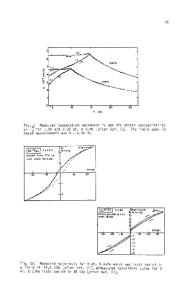From Spin Glasses to Glasses
- PDF / 419,521 Bytes
- 7 Pages / 414.72 x 648 pts Page_size
- 65 Downloads / 359 Views
.J.P. BOUCItAUD*, M. MEZARD** *
Service de Physique de 1'tat Condens6, Centre I'Atuldes de Saclay, ()rme lies
Merisiers, 91191 Gif-sur- Yvetle C6dex, FI{ANC(i' "**Laboratoire de Physique ThCori(lie de I'Ecole Norniale Sup6rieure, * 24 rue Lhomond, 75231 Paris Cedex 05, FRANCE
ABSTRACT: We discuss some aspects of the links between the behaviour and theory of spin glasses and that o)f structural glasses of the fragile type. We review the present status o, the couljectlure, acci'ordhig tIo w6hi0h a cvrktaij class of' Spil glass ii ean lield theories (those with first; order t-ransitions) coild provide a ineai hield theory for the glass transition. Recent, developmlets pointing in that direction inclu(le the existence of spin glasses without disorder, and the general link b)et.ween Mode-Coupling Theory (MCT) and the motion of a particle in a random potential. This link enables one
to generalize the MCI' equations for teml)eratlres beh)w the glass transition, and Lo describe aging effects. We compare these results with those obtained within more plhenomenological tirap' models.
A priori there exist; striking differences between the behaviour and the basic constitutive ingredients of spin glasses on the one hand and structural glasses on the other haiid. Let us mention a few of the most obviotis ones. The first, one that comes to rmindl is the existemice of quenched (disorder in spin glasses (for instance the Mn impurities in CuMn do not move o01experimental time scales, and therefore the magnetic exchange coupli)igs are frozen), while in glass forming liquids there is a priori no quenched disorder: disorder is "self induced" by the gradual freezing of some degrees of freedom. This inducess a secoud difference, namely the existence of a crystalline state in glasses with no coujiterpart in spin glasses. A third one is the fact that the glass transition is a dynanmic effect, basically deftied as the temperature or density at which the relaxaLiou times reaclhes tile experimentally accessible order * UnitO propre dit CNRS, associ.e h l'Ecolh Normale Supdrieure et,
de Paris Stid 203 Mat. Res. Soc. Symp. Proc. Vol. 455 0 1997 Materials Research Society
l'hmUniversit;
of magnitudes of hours. In spin glasses there exists rather good evidence in favour of the existence of a second order l)hase transition at; least in zero magnetic field, with a power law singularity of the non linear magnetic susceptibility. In spite of these seemingly crucial differences, there is increasing convergence between some of the theoretical ideas developped inl the two fields. A first step in this direction is the understanding that there exist two very (lifferent typ)es of mean field spin glasses. While the most conventional ones like the Sherrington-Kirkpatrick model provide a good starting point for the d(escription of real spin glasses, there exist a second class, which is characterized by a (liscontinuous static phase transition at a temperature T.,. The discoontinuity is that of the Edwards-Anderson order parameter, while the transition
Data Loading...











